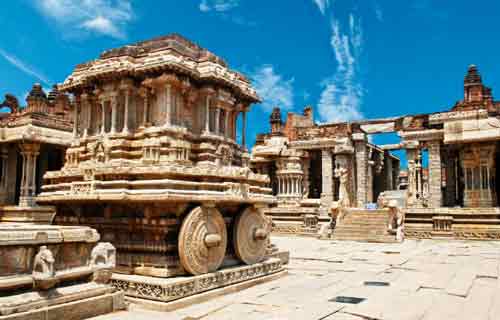Hampi is an ancient site that once used to be the royal capital of the Vijayanagar Empire. Known as the ‘city of ruins’, Hampi is a small village in the northern part of Karnataka. Hampi is regarded as one of the most beautiful towns in Karnataka. Located near Hospet, Hampi is easily accessible by regular tourist buses from the major cities and towns of Karnataka. Hampi, the village is upkeeping the religious roots that were sownby the Vijayanagar rulers in the form of its temples.
Virupaksha Temple

Virupaksha Temple is the most famous shrine at Hampi. Also known as Pampapathi Temple, the shrine is completely untouched by the destruction that was seen by many monuments in the 16th century. Virupaksha Temple has three towers, where the eastern tower rises to 160 feet with nine tiers. The temple traces its origin in the first half of the fifteenth century; however it was refurbished by Krishnadevaraya in the 16th century.
The temple walls are adorned with manifested images of Shiva and Vishnu. The murals depict various scenes from the epics of Ramayana and Mahabharata. In the close proximity of Virupaksha Temple, one can see numerous ruined mandapams. This place used to be the affluent market and shopping center of the largest Hindu empire. The famous monolith structure of Ugra Narasimha or Lakshmi Narasimha is to be found near this temple. Every year in February, Chariot festival is celebrated here with full gusto and fervor.
Vitthala Temple

Vitthala Temple is considered as the most impressive and most ornate of all the temples at Hampi. The presiding deity of the temple is Lord Vitthala (form of Lord Vishnu). The foreground of the sanctum is made by the ‘mahamandapam’ (pillared hall), which is tremendously ornamented. Its pedestal is engraved with friezes of the swan, the horse and the warrior. At breaks, there are projections carved with reliefs illustrating the ten incarnations of Lord Vishnu. The flight of steps on the east of hall is bordered by an elephant handrail.
The portico is adorned with forty pillars, where each group of columns comprises a central pillar with lean duct around. In the center of hall, there are sixteen pillars festooned with images of Narsimha and Yali. Highly intricate sculptural work can also be traceable on the ceiling of Mahamandapam. Vitthala Temple is celebrated for its much famed stone chariot. The stone wheels of this chariot are twisted in the form of a lotus. As a matter of fact, these wheels are fully competent in revolving. The artistic structure of this chariot reflects the noteworthy creativity of the artisans of the fifteenth century.

